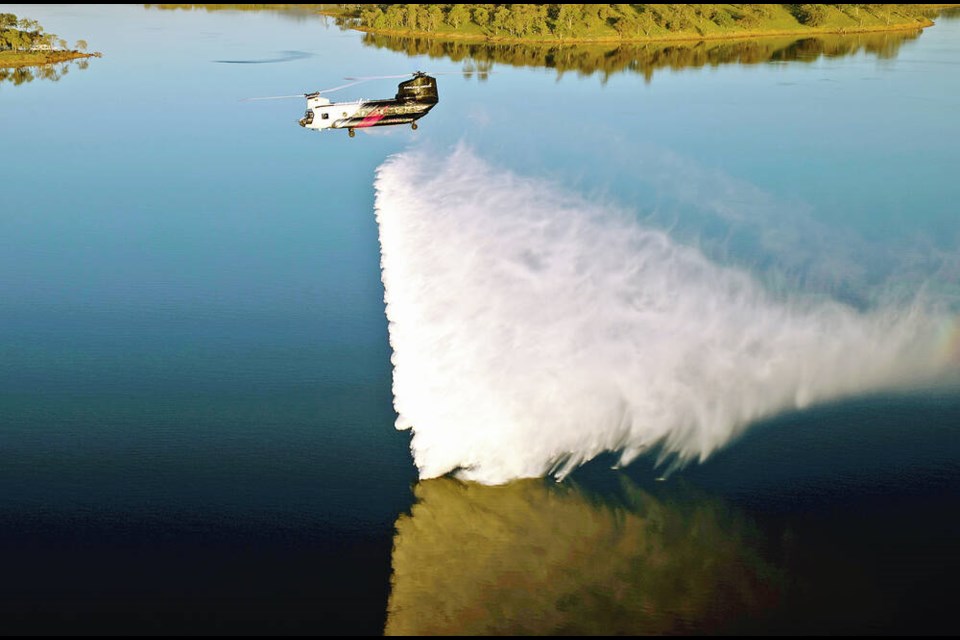Island-based Coulson Aviation’s night-flying, high-tech helicopter fleet is being showcased on the CBS news program 60 Minutes tonight.
Its quick response force comes from partnering technology with custom operating procedures and the ability to drop many thousands of gallons of water and retardant in specific locations.
“It’s proven out everything we thought it could do, it can do and more,” said Wayne Coulson, chief executive of the Coulson Group of Companies.”
The company’s two C-47 Chinook helicopters in California have been equipped with computerized tanks capable of carrying 3,000 gallons each.
Millions of viewers will see Coulson’s four-helicopter team quick response force battle massive blazes throughout the night in California. The show airs at 7 p.m.
The fleet works during the day, too, but what’s uncommon is its ability to drop huge amounts of water or retardant in precise locations during the night when other aircraft are normally grounded.
“We are the only commercial operator in the world that runs at night,” said Coulson.
Coulson Aviation is part of a family-owned company based in Port Alberni. It is renowned in sa���ʴ�ý for its Martin Mars water bombers, once a common sight when forest fires broke out.
The quick-response force has its roots on Vancouver Island when Wayne Coulson and his team carried out trials at the Port Alberni Regional Airport more than a decade ago. “We took all kinds of technology. We married them together to work as one.”
The company invested in training pilots, buying huge helicopters and adapting them for night-time firefighting, and purchasing technology such as state-of-the-art night-vision goggles. Standard operating procedures focusing on safety were developed because it is riskier to fight fires at night than during the day.
Coulson has won contracts with its night-time firefighting service in Australia and Chile as well. It has not been able to get contracts in sa���ʴ�ý although Wayne Coulson believes it would be effective here.
The heavyweights of its quick response force are two C-47 Chinook helicopters equipped with computerized tanks. A Sikorsky S-61 tanker supports them as does the intelligence helicopter, a Sikorsky S-76.
Flows out of a C-47’s tank can be regulated to go as fast or slow as operators desire, depending on what it going on with a particular fire, Coulson said. A tank can flow up to 2,000 gallons per second, the highest flow rate in the world, he said.
Helicopters drop either water, water injected with gel, or retardant.
“What we’ve tried to do is put enough technology on board the aircraft with the tanking system to provide the optimum tool for our flight crews to knock that fire out.”
When huge fires break out, they not only threaten homes and buildings but take out power lines. Southern California Edison is behind a two-year-test in three California counties using the quick response force.
The helicopters helped tackle the Silverado fire in October and November last year in Orange County. “It [the fire] was going to run into a community and we were able to hold the fire,” Coulson said.
The quick response force sees a C-47 based in Los Angeles County, another in Orange County, and a third helicopter, a Sikorsky S-61, in Ventura County. The fourth helicopter, a Sikorsky S-76, is fitted out with a thermal imaging camera and a laser super camera. Operators 1,500 feet in the air can pinpoint locations for drops.
The fleet incorporates intelligence it gathers from a variety of agencies. It sends real-time information to the University of San Diego’s super computer which responds with predictions of how many structures are at risk, where the fire will burn and how quickly. The super computer updates its predictions every 30 minutes.
Coulson Aviation used two tactics this summer at the Caldor fire, southwest of Lake Tahoe. Retardant was dropped ahead of the blaze and around homes to “box them in” by stopping the fire in those locations to protect structures, Coulson said.
Retardant was also dropped on the head (the fastest-spreading part of fire) of the fire to slow it down as it approached the buildings.
Coulson figures hundreds of structures were saved using those methods.
The fire season continues and Coulson frequently travels back and forth between Port Alberni and California. The Santa Ana winds, which fuel fires, are due anytime now.
- - -
To comment on this article, send a letter to the editor: [email protected]



